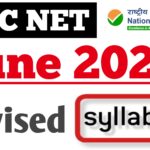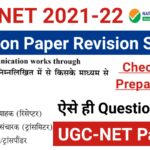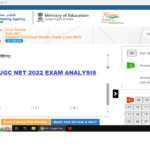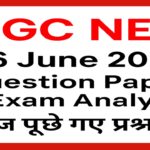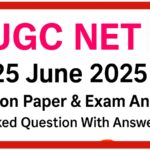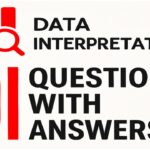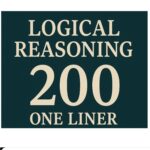Get access to the latest Ugc Net Research Aptitude Most Expected & Important MCQ (50 ) with detailed Answers (in Hindi & English ) prepared for NTA-UGC NET/SET/PHD Coming Examination .
1. Which of the following rightly signifies/signify limitations of positivistic approach to research?
a) Limitations built basis for the development of not only post-positivism but also interpretivism.
b) Epistemology of positivism failed to appreciate overall human involvement while applying quantitative research methods to get knowledge of reality.
c) Post-positivistic approach to research emerged as a substitute of positivistic approach to research as a fallout of limitations of positivism.
d) But for its limitations, positivistic approach to research could not take post-positivism as its supplement approach to research.
(A) a and c only
(B) b and d only
(C) a, b, c, and d
(D) b and c only
1. निम्नलिखित में से कौन सा सही दर्शाता है/अनुसंधान के लिए सकारात्मक दृष्टिकोण की सीमाओं का प्रतीक है?
क) सीमाएं न केवल सकारात्मकता के बाद के विकास के लिए आधार बनाया है, लेकिन यह भी व्याख्या ।
ख) सकारात्मकता की महामारी वास्तविकता का ज्ञान प्राप्त करने के लिए मात्रात्मक अनुसंधान विधियों को लागू करते समय समग्र मानव भागीदारी की सराहना करने में विफल रही ।
ग) अनुसंधान के लिए सकारात्मक दृष्टिकोण के बाद सकारात्मकता की सीमाओं के परिणाम के रूप में अनुसंधान के लिए सकारात्मक दृष्टिकोण के एक विकल्प के रूप में उभरा ।
घ) लेकिन अपनी सीमाओं के लिए, अनुसंधान के लिए सकारात्मक दृष्टिकोण अनुसंधान के लिए अपने पूरक दृष्टिकोण के रूप में सकारात्मकता के बाद नहीं ले सकता है ।
(A) ए और सी केवल
(B) b और d केवल
(C) ए, बी, सी, और डी
(डी) बी और सी ही
2. Which of the following concept of research was termed as ‘First Philosophy’ by Aristotle?
(A) Metaphysics
(B) Ontology
(C) Interpretivism
(D) Axiology
2. अनुसंधान की निम्नलिखित अवधारणा में से किस को अरस्तू द्वारा ‘पहला दर्शन’ कहा गया था?
(क) मेटाफिजिक्स
(ख) ओंटोलॉजी
(ग) व्याख्यावाद
(घ) स्वयंसिद्ध विज्ञान
3. Column I Column II
a) Phenomenology i) Thomas Kuhn
b) Post-Positivism ii) Paul Lapie
c) Paradigm iii) Edmund Husserl
d) Axiology iv) Karl Popper
(A) iii iv i ii
(B) ii iv iii i
(C) iv iii ii i
(D) ii i iv iii
3. कॉलम I कॉलम II
क) दृश्यपंचशास्त्र i) थॉमस कुह्न
ख) पोस्ट-सकारात्मकता ii) पॉल लापी
ग) प्रतिमान iii) एडमंड हसेर्ल
घ) स्वयंसिद्ध विज्ञान iv) कार्ल पॉपर
(A) iii iv i ii
(B) ii iv iii i
(C) iv iii ii i
(D) ii i iv iii
4. Which of the following is NOT a characteristics of Positivist approach to research?
(A) Quantitative research methods
(B) Large sized target population
(C) Unstructured investigation
(D) Generalisation of research findings
4. निम्नलिखित में से कौन सा अनुसंधान के लिए सकारात्मक दृष्टिकोण की विशेषताएं नहीं है?
(क) मात्रात्मक अनुसंधान विधियां
(ख) बड़े आकार की लक्ष्य आबादी
(ग) असंरचित जांच
(घ) अनुसंधान निष्कर्षों का सामान्यीकरण
5. Consider the statement, “It does not accept abstract traits of human behaviour like emotions and sentiments as source of knowledge”. This statement signifies which approach to research?
(A) Postivistic
(B) Post-postivistic
(C) Interpretivistic
(D) Constructivistic
5. बयान पर विचार करें, “यह भावनाओं और भावनाओं की तरह मानव व्यवहार के अमूर्त लक्षण ज्ञान के स्रोत के रूप में स्वीकार नहीं करता है.” यह कथन अनुसंधान के लिए कौन सा दृष्टिकोण दर्शाता है?
(क) पोस्टिविस्टिक
(ख) पोस्ट-पोस्टिविवादी
(ग) व्याख्यावादी
(घ) रचनात्मकता
6. Which of the following paradigms does not advocate quantitative method of research?
(A) Positivism, Ontology, Axiology
(B) Post-positivism, Phenomenology, Epistemology
(C) Interpretivism, Constructivism, Realism
(D) All of the above
6. निम्नलिखित प्रतिमानों में से कौन सा अनुसंधान की मात्रात्मक विधि की वकालत नहीं करता है?
(क) सकारात्मकता, ओंटोलॉजी, स्वयंसिद्धि
(ख) सकारात्मकता के बाद, फेनोमेनोलॉजी, एपिस्टेमोलॉजी
(ग) व्याख्यावाद, रचनात्मकता, यथार्थवाद
(घ) उपरोक्त सभी
7. In which of the following approaches to research, independent variable is manipulated to observe the effect on dependent variable?
a) Post-positivistic
b) Positivistic
c) Intrepretivistic
d) Phenomenological
(A) a and c only
(B) b only
(C) a and b only
(D) a and d only
7. अनुसंधान के लिए निम्नलिखित दृष्टिकोणों में से किसमें, निर्भर चर पर प्रभाव का निरीक्षण करने के लिए स्वतंत्र चर में हेरफेर किया जाता है?
क) सकारात्मकता के बाद
ख) सकारात्मकता
ग) निडरतावादी
घ) फेनोमेनोलॉजिकल
(A) ए और सी केवल
(बी) बी केवल
(C) ए और बी केवल
(डी) ए और डी केवल
8. If a research scholar is investigating whether gesture of present day hospitality really values the guests or it is just a demonstration, which research approach is he following?
(A) Ontology
(B) Phenomenology
(C) Pragmatism
(D) Axiology
8. यदि एक शोध विद्वान जांच कर रहा है कि क्या वर्तमान दिन आतिथ्य के इशारे वास्तव में मेहमानों को महत्व देता है या यह सिर्फ एक प्रदर्शन है, जो अनुसंधान दृष्टिकोण वह पीछा कर रहा है?
(क) ओंटोलॉजी
(ख) फेनोमेनोलॉजी
(ग) व्यावहारिकता
(घ) स्वयंसिद्ध विज्ञान
9. Interpretivism is ___________ to positivism.
(A) supplementary
(B) contrast
(C) prior
(D) similar
9. व्याख्यावाद सकारात्मकता के लिए है ।
(A) अनुपूरक
(B) वैषम्य
(C) पूर्व
(D) समान
10. Which of the following research paradigm is compatible to Positivism?
(A) Realism
(B) Interpretivism
(C) Constructivism
(D) None of these
10. निम्नलिखित शोध प्रतिमान में से कौन सा सकारात्मकता के अनुकूल है?
(A) यथार्थवाद
(B) व्याख्यावाद
(C) रचनात्मकता
(D) इनमें से कोई नहीं
11. While conducting a research on a customary ritual of a particular community, a researcher puts high value to objective of education and awareness. Which paradigm of research is he following?
(A) Ontology
(B) Pragmatism
(C) Axiology
(D) Constructivism
11. एक विशेष समुदाय के एक प्रथागत अनुष्ठान पर एक शोध आयोजित करते समय, एक शोधकर्ता शिक्षा और जागरूकता के उद्देश्य के लिए उच्च मूल्य डालता है । अनुसंधान के किस प्रतिमान वह पीछा कर रहा है?
(A) ओंटोलॉजी
(B) व्यावहारिकता
(C) स्वयंसिद्ध विज्ञान
(D) रचनात्मकता
12. The interpretive approach to scientific research generates which of the following?
(A) Knowledge which assists with personal liberation and freedom of constraints on one’s rationale and independence
(B) Knowledge which is dependent up on the process of discovery
(C) Proven facts
(D) Evidence of generalizable laws not affected by context
12. वैज्ञानिक अनुसंधान के लिए व्याख्यात्मक दृष्टिकोण निम्नलिखित में से कौन सा उत्पन्न करता है?
(क) ज्ञान जो व्यक्तिगत मुक्ति और किसी के औचित्य और स्वतंत्रता पर बाधाओं की स्वतंत्रता के साथ सहायता करता है
(ख) ज्ञान जो खोज की प्रक्रिया पर निर्भर है
(ग) सिद्ध तथ्य
(घ) सामान्य रूप से कानूनों के साक्ष्य संदर्भ से प्रभावित नहीं
13. ‘Critical realism’ is the characteristic of which approach to research?
(A) Post-positivism
(B) Positivism
(C) Realism
(D) Phenomenology
13. ‘क्रिटिकल यथार्थवाद’ अनुसंधान के लिए किस दृष्टिकोण की विशेषता है?
(क) सकारात्मकता के बाद
(ख) सकारात्मकता
(ग) यथार्थवाद
(घ) फेनोमेनोलॉजी
14. A study exploring the economic impact of the Olympic Games would normally be related to which approach?
(A) Positivistic
(B) Interpretivistic
(C) Post-positivistic
(D) None of these
14. ओलंपिक खेलों के आर्थिक प्रभाव की खोज करने वाला एक अध्ययन आम तौर पर किस दृष्टिकोण से संबंधित होगा?
(A) सकारात्मक
(B) व्याख्यावादी
(C) पोस्ट-सकारात्मकवादी
(D) इनमें से कोई नहीं
15. Which is NOT generally a characteristic of Postivist research?
(A) Control by researcher
(B) Hypothesis testing
(C) Use of interview
(D) Replication
15. जो आम तौर पर Postivist अनुसंधान की एक विशेषता नहीं है?
(क) शोधकर्ता द्वारा नियंत्रण
(B) परिकल्पना परीक्षण
(C) साक्षात्कार का उपयोग
(D) प्रतिकृति
16. Which one of the following statements characterises the difference in observation methods using the Interpretive approach versus Post-positivist approach?
(A) Interpretive approach relies on a flexible set of rules, whereas the post-positivist approach relies on the social, linguistic, and cognitive skills of the researcher.
(B) Interpretive approach relies on a firm and unchanging set of rules, whereas the postpositivist approach relies on the social, linguistic, and cognitive skills of the studied subjects.
(C) Post-positivist approach relies on a flexible set of rules, whereas the interpretive approach relies on the social, linguistic, and cognitive skills of the researcher.
(D) Post-positivist approach relies on firm and unchanging set of rules, whereas the interpretive approach relies on the social, linguistic, and cognitive skills of the researcher.
16. निम्नलिखित कथनों में से कौन सा व्याख्यात्मक दृष्टिकोण बनाम सकारात्मक दृष्टिकोण का उपयोग करके अवलोकन विधियों में अंतर की विशेषता है?
(क) व्याख्यात्मक दृष्टिकोण नियमों के लचीले सेट पर निर्भर करता है, जबकि सकारात्मकता के बाद का दृष्टिकोण शोधकर्ता के सामाजिक, भाषाई और संज्ञानात्मक कौशल पर निर्भर करता है ।
(ख) व्याख्यात्मक दृष्टिकोण नियमों के एक दृढ़ और अपरिवर्तनीय सेट पर निर्भर करता है, जबकि पोस्टपोजिस्ट दृष्टिकोण अध्ययन किए गए विषयों के सामाजिक, भाषाई और संज्ञानात्मक कौशल पर निर्भर करता है ।
(ग) सकारात्मकता के बाद का दृष्टिकोण नियमों के लचीले सेट पर निर्भर करता है, जबकि व्याख्यात्मक दृष्टिकोण शोधकर्ता के सामाजिक, भाषाई और संज्ञानात्मक कौशल पर निर्भर करता है ।
(घ) पोस्ट-सकारात्मक दृष्टिकोण नियमों के दृढ़ और अपरिवर्तनीय सेट पर निर्भर करता है, जबकि व्याख्यात्मक दृष्टिकोण शोधकर्ता के सामाजिक, भाषाई और संज्ञानात्मक कौशल पर निर्भर करता है ।
17. In the post-positivistic approach to research which of the following types of research got emphasised?
a) Experimental research
b) Phenomenological Research
c) Ethnographic Research
d) Ex-post Facto Research
e) Action Research
(A) (a), (b) and (c)
(B) (b), (c) and (d)
(C) (b), (c) and (e)
(D) (c), (d) and (e)
17. अनुसंधान के बाद सकारात्मक दृष्टिकोण में अनुसंधान के निम्नलिखित प्रकार के किस पर जोर दिया गया?
क) प्रायोगिक अनुसंधान
ख) फेनोमेनोलॉजिकल रिसर्च
ग) नृवंशविज्ञान अनुसंधान
घ) पूर्व पोस्ट फैक्टो रिसर्च
ई) एक्शन रिसर्च
(A) (a), (b) and (c)
(B) (b), (c) and (d)
(C) (b), (c) and (e)
(D) (c), (d) and (e)
18 A research work completed with a step-wise approach, is always
(A) time consuming because while following various steps, a researcher is to fulfil various formalities
(B) effective because various steps followed during research process fulfil the ethics of undertaking research, hereby increasing its chances of being accurate and unambiguous.
(C) attractive because steps undertaken during research give the research work a beautiful shape
(D) None of these
18 एक अनुसंधान काम एक कदम के साथ पूरा दृष्टिकोण, हमेशा है
(क) समय लेने में समय लगता है क्योंकि विभिन्न चरणों का पालन करते समय, एक शोधकर्ता विभिन्न औपचारिकताओं को पूरा करना है
(ख) प्रभावी है क्योंकि अनुसंधान प्रक्रिया के दौरान अपनाई गई विभिन्न कदम अनुसंधान करने की नैतिकता को पूरा करते हैं, जिससे सटीक और सुस्पष्ट होने की संभावना बढ़ जाती है ।
(ग) आकर्षक है क्योंकि अनुसंधान के दौरान किए गए कदम अनुसंधान कार्य को एक सुंदर आकार देते हैं
(घ) इनमें से कोई भी नहीं
19. Which of the following is not considered during the step of Preparing the Research Design?
(A) Source of information
(B) Consulting empirical literature
(C) Availability of time
(D) Cost to be incurred
19. अनुसंधान डिजाइन तैयार करने के कदम के दौरान निम्नलिखित में से किस पर विचार नहीं किया जाता है?
(क) सूचना का स्रोत
(ख) परामर्श अनुभवजन्य साहित्य
(ग) समय की उपलब्धता
(घ) खर्च की जाने वाली लागत
20. Following steps are generally followed in a research process:
I) Preparation of Synopsis
II) Collection of data
III) Execution of the project
IV) Hypothesis testing. Arrange them in chronology.
(A) I-II-III-IV
(B) II-I-III-IV
(C) III-I-IV-II
(D) IV-III-II-I
20. निम्नलिखित चरणों को आम तौर पर एक शोध प्रक्रिया में पालन किया जाता है:
I) सारांश की तैयारी
II) आंकड़ों का संग्रह
III) परियोजना का निष्पादन
IV) परिकल्पना परीक्षण। उन्हें कालक्रम में व्यवस्थित करें।
(A) I-II-III-IV
(B) II-I-III-IV
(C) III-I-IV-II
(D) IV-III-II-I
21. For understanding a research problem, the best way before a researcher is to consult his _____.
(A) mind
(B) colleagues
(C) Head of the department
(D) none of the above
21. एक शोध समस्या को समझने के लिए, शोधकर्ता के सामने सबसे अच्छा तरीका यह है कि वह अपने _____ से परामर्श करे।
(क) मन
(ख) सहकर्मी
(ग) विभागाध्यक्ष
(घ) उपरोक्त में से कोई नहीं
22. In the research process the step of developing working hypothesis comes after the step of
(A) Rephrasing of the problem
(B) Preparing the research design
(C) Preparing synopsis
(D) Collection of data
22. अनुसंधान प्रक्रिया में काम परिकल्पना विकसित करने के कदम के बाद आता है
(A) समस्या का पुनर्खराज
(B) अनुसंधान डिजाइन तैयार करना
(C) सारांश
(डी) डेटा का संग्रह तैयार करना
23. Library plays an important part in one of the methods of research because ____.
(A) nature of hypothesis differs
(B) nature of data to be collected differs
(C) nature of research scholars differs
(D) none of these
23. पुस्तकालय अनुसंधान के तरीकों में से एक में एक महत्वपूर्ण भूमिका निभाता है क्योंकि _____ ।
(क) परिकल्पना की प्रकृति अलग-अलग होती है
(ख) एकत्र किए जाने वाले आंकड़ों की प्रकृति अलग-अलग होती है
(ग) शोध विद्वानों की प्रकृति अलग-अलग
(घ) इनमें से कोई नहीं
24. Quantitative method of research is successful in case of those variables which
(A) are accepted by the methodology
(B) are easily measurable
(C) require knowledge of quantitative techniques
(D) none of the above
24. अनुसंधान की मात्रात्मक विधि उन चर के मामले में सफल है जो
(क) कार्यप्रणाली द्वारा स्वीकार किए जाते हैं
(ख) आसानी से मापने योग्य हैं
(ग) मात्रात्मक तकनीकों के ज्ञान की आवश्यकता है
(घ) उपरोक्त में से कोई नहीं
25. No method of research is successful until and unless research scientist ______.
(A) makes it compatible to the chosen problem
(B) verifies its validity well before adopting it in the research
(C) adopts it and verifies its validity
(D) none of these
25. अनुसंधान का कोई तरीका तब तक सफल नहीं होता है जब तक कि अनुसंधान वैज्ञानिक ______
(क) यह चुना समस्या के लिए संगत बनाता है
(ख) अनुसंधान में इसे अपनाने से पहले इसकी वैधता की अच्छी तरह से पुष्टि करता है
(ग) इसे अपनाता है और इसकी वैधता की पुष्टि करता है
(घ) इनमें से कोई नहीं
26. Under which method research is undertaken under controlled conditions?
(A) Quantitative
(B) Experimental
(C) Qualitative
(D) Comparative
26. नियंत्रित परिस्थितियों में किस विधि अनुसंधान के तहत किया जाता है?
(क) मात्रात्मक
(ख) प्रायोगिक
(ग) गुणात्मक
(घ) तुलनात्मक
27. In the field, a research scholar collects a data which can be attributed to……method of research.
(A) Experimental
(B) Field survey
(C) Quantitative
(D) Any of these
27. क्षेत्र में, एक शोध विद्वान एक डेटा एकत्र करता है जिसे जिम्मेदार ठहराया जा सकता है …… अनुसंधान की विधि।
(क) प्रायोगिक
(ख) फील्ड सर्वे
(ग) मात्रात्मक
(घ) इनमें से कोई भी
28 Which of the following is NOT an ethics of research?
(A) Ordering
(B) Planning
(C) Imitating
(D) Indiscriminating
28. निम्नलिखित में से कौन सा अनुसंधान की नैतिकता नहीं है?
(A) आदेश
(B) योजना
(C) नकल
(D) अभेद
29. Which is the most popular method of conducting research?
(A) Quantitative
(B) Experimental
(C) Field survey
(D) Can’t say
29. अनुसंधान करने का सबसे लोकप्रिय तरीका कौन सा है?
(A) मात्रात्मक
(B) प्रायोगिक
(C) फील्ड सर्वे
(डी) नहीं कह सकते
30. Adoption of research ethics makes a research work ______.
(A) practical
(B) ideal
(C) ethical
(D) popular
30. अनुसंधान नैतिकता को अपनाने से एक शोध कार्य किया जाता है ।
(क) व्यावहारिक
(ख) आदर्श
(ग) नैतिक
(घ) लोकप्रिय
31Assertion (A): Research design is an index of the whole research process.
Reason (R): It constitutes sampling technique of data collection, method of research, hypothesis under study, analysis, and findings.
(A) Both A and R are true and R is correct explanation of A
(B) Both A and R are true but R is not correct explanation of A
(C) A is true but R is false
(D) A is false but R is true
31दावा (ए): अनुसंधान डिजाइन पूरी शोध प्रक्रिया का एक सूचकांक है।
कारण (नि.): यह डेटा संग्रह, अनुसंधान की विधि, अध्ययन, विश्लेषण और निष्कर्षों के तहत परिकल्पना की नमूना तकनीक का गठन करता है।
(क) ए और आर दोनों सच हैं और आर ए का सही स्पष्टीकरण है
(ख) ए और आर दोनों सच हैं लेकिन आर ए का सही स्पष्टीकरण नहीं है
(ग) एक सच है, लेकिन आर झूठी है
(घ) एक झूठा है, लेकिन आर सच है
32. Assertion (A): Replication of a research is generally not supported by ethics of research. Reason (R): A research work becomes ethical if completed without interference of a guide.
(A) Both A and R are true and R is correct explanation of A
(B) Both A and R are true but R is not correct explanation of A
(C) Both A and R are false
(D) A is false but R is true
32. दावा (ए): एक शोध की प्रतिकृति आम तौर पर अनुसंधान की नैतिकता द्वारा समर्थित नहीं है । कारण (नि.): एक शोध कार्य नैतिक हो जाता है यदि एक गाइड के हस्तक्षेप के बिना पूरा हो जाता है।
(क) ए और आर दोनों सच हैं और आर ए का सही स्पष्टीकरण है
(ख) ए और आर दोनों सच हैं लेकिन आर ए का सही स्पष्टीकरण नहीं है
(ग) ए और आर दोनों झूठे हैं
(घ) एक झूठा है, लेकिन आर सच है
33. Assertion (A): Various reforms in present day research are inspired from historical method of research.
Research (R): History reveals that research had been a means to progress even in the ancient times. (A) Both A and R are false
(B) A is true but R is false
(C) A is false but R is true
(D) Both A and R are true and R is correct explanation of A
33. दावा (ए): वर्तमान अनुसंधान में विभिन्न सुधार अनुसंधान की ऐतिहासिक विधि से प्रेरित हैं।
अनुसंधान (नि.): इतिहास से पता चलता है कि अनुसंधान प्राचीन काल में भी प्रगति करने का एक साधन रहा था । (क) ए और आर दोनों झूठे हैं
(ख) एक सच है, लेकिन आर झूठी है
(ग) एक झूठा है, लेकिन आर सच है
(घ) ए और आर दोनों सच हैं और आर ए का सही स्पष्टीकरण है
34. Assertion (A): Developing working hypothesis is a pivotal step of the research process. Reason (R): Various steps of research process minimise the chances of any bias in research.
(A) Both A and R are true and R is correct explanation of A
(B) A is true but R is false
(C) A is false but R is true
(D) Both A and R are true but R is not correct explanation of A
34. जोर (ए): काम परिकल्पना का विकास अनुसंधान प्रक्रिया का एक निर्णायक कदम है । कारण (नि.): अनुसंधान प्रक्रिया के विभिन्न कदम अनुसंधान में किसी भी पूर्वाग्रह की संभावना को कम करते हैं।
(क) ए और आर दोनों सच हैं और आर ए का सही स्पष्टीकरण है
(ख) एक सच है, लेकिन आर झूठी है
(ग) एक झूठा है, लेकिन आर सच है
(घ) ए और आर दोनों सच हैं लेकिन आर ए का सही स्पष्टीकरण नहीं है
35Assertion (A): Quantitative method of research houses experimental method of research.
Reason (R): Research on natural sciences involve quantitative and experimental methods of research. (A) Both A and R are true and R is correct explanation of A
(B) A is true but R is false
(C) A is false but R is true
(D) Both A and R are true but R is not correct explanation of A
35दावा (ए): अनुसंधान की मात्रात्मक विधि अनुसंधान की प्रायोगिक विधि है।
कारण (नि.): प्राकृतिक विज्ञान पर अनुसंधान में अनुसंधान के मात्रात्मक और प्रयोगात्मक तरीके शामिल हैं । (क) ए और आर दोनों सच हैं और आर ए का सही स्पष्टीकरण है
(ख) एक सच है, लेकिन आर झूठी है
(ग) एक झूठा है, लेकिन आर सच है
(घ) ए और आर दोनों सच हैं लेकिन आर ए का सही स्पष्टीकरण नहीं है
36. Assertion (A): Philosophical method of research aims at achieving pragmatism.
Reason (R): Meaning of ideas is determined in the research process and the aim is to clarify them. (A) Both A and R are true but R is not correct explanation of A
(B) Both A and R are true and R is correct explanation of A
(C) A is true but R is false
(D) A is false but R is true
36. दावा (ए): अनुसंधान की दार्शनिक विधि का उद्देश्य व्यावहारिकता प्राप्त करना है।
कारण (नि.): विचारों का अर्थ अनुसंधान प्रक्रिया में निर्धारित किया जाता है और उद्देश्य उन्हें स्पष्ट करना है। (क) ए और आर दोनों सच हैं लेकिन आर ए का सही स्पष्टीकरण नहीं है
(ख) ए और आर दोनों सच हैं और आर ए का सही स्पष्टीकरण है
(ग) एक सच है, लेकिन आर झूठी है
(घ) एक झूठा है, लेकिन आर सच है
37. The components of a research design are:
(a) Comparison
(b) Control
(c) Reactivity
(d) Manipulation
(e) Non-representativeness
(f) Generalisation
(A) (c), (d), (e), and (f)
(B) (a), (c), (e), and (f)
(C) (b), (c), (d), and (e)
(D) (a), (b), (d), and (f)
37. एक शोध डिजाइन के घटक हैं:
(क) तुलना
(ख) नियंत्रण
(ग) रिएक्टिविटी
(घ) हैंडलिंग
(ङ) गैर-प्रतिनिधिता
(च) सामान्यीकरण
(A) (c), (d), (e), and (f)
(B) (a), (c), (e), and (f)
(C) (b), (c), (d), and (e)
(D) (a), (b), (d), and (f)
38. The conceptual framework in which a research is conducted is called a
(A) Synopsis of research
(B) Research design
(C) Research hypothesis
(D) Research paradigm
38 जिस वैचारिक ढांचे में एक शोध किया जाता है उसे एक कहा जाता है
(A) सारांश अनुसंधान
(B) अनुसंधान डिजाइन
(C) अनुसंधान परिकल्पना
(D) अनुसंधान प्रतिमान
39. A university teacher intends to study relationship between level of aspiration and achievement of rural children. Which design of research will be the most appropriate in the context?
1) Experimental research design
2) Ex Post facto research design
3) Historical research design
4) Survey research design
39. एक विश्वविद्यालय के शिक्षक आकांक्षा और ग्रामीण बच्चों की उपलब्धि के स्तर के बीच संबंधों का अध्ययन करना चाहता है । अनुसंधान का कौन सा डिजाइन संदर्भ में सबसे उपयुक्त होगा?
1) प्रायोगिक अनुसंधान डिजाइन
2) पूर्व पोस्ट फैक्टो अनुसंधान डिजाइन
3) ऐतिहासिक अनुसंधान डिजाइन
4) सर्वेक्षण अनुसंधान डिजाइन
40. Which o the following sequences of represents the most logical sequence of doing research?
(A) Identifying and defining a research problem, formulating a hypothesis, testing of hypothesis and reporting the results.
(B) Identify a research problem, defining the population and sample, collecting data and analysis of data
(C) Survey of research, defining the research problem, collecting data and presenting the outcomes. (D) Defining research variables, hypothesizing, testing of research and reporting of research outcomes
40. कौन सा ओ के निम्नलिखित दृश्यों अनुसंधान करने का सबसे तार्किक अनुक्रम का प्रतिनिधित्व करता है?
(क) किसी अनुसंधान समस्या की पहचान करना और उसे परिभाषित करना, परिकल्पना तैयार करना, परिकल्पना का परीक्षण करना और परिणामों की रिपोर्ट करना ।
(ख) किसी शोध समस्या की पहचान करें, जनसंख्या और नमूने को परिभाषित करें, डेटा एकत्र करें और आंकड़ों का विश्लेषण करें
(ग) अनुसंधान सर्वेक्षण, अनुसंधान समस्या को परिभाषित करना, आंकड़े एकत्र करना और परिणाम प्रस्तुत करना । (घ) अनुसंधान चर को परिभाषित करना, परिकल्पना करना, अनुसंधान का परीक्षण और अनुसंधान परिणामों की रिपोर्टिंग
41. Formulation of a research problem can be compared to
(A) Laying the foundation of a building
(B) Building the walls of a home
(C) Polishing the doors of a building
(D) Constructing the ceiling of a house
41. एक शोध समस्या के निर्माण की तुलना में किया जा सकता है
(क) किसी भवन की नींव डालने का कार्य
(ख) घर की दीवारों का निर्माण
(ग) एक इमारत के दरवाजे चमकाने
(घ) एक घर की छत का निर्माण
42. Formulation of a research problem depends on:
(a) What is the object behind the researcher’s choice?
(b) What are the specific questions?
(c) What is the conceptual model?
(d) What negative factors to research upon?
(e) Reasons for unlimiting the study.
(f) Construction of hypotheses.
(A) (a), (c), (e), and (f)
(B) (c), (d), (e), and (f)
(C) (b), (c), (d), and (e)
(D) (a), (b), (c), and (f)
42. एक शोध समस्या का निर्माण पर निर्भर करता है:
(क) शोधकर्ता की पसंद के पीछे क्या वस्तु है?
(ख) विशिष्ट प्रश्न क्या हैं?
(ग) संकल्पनात्मक मॉडल क्या है?
(घ) अनुसंधान करने के लिए किन नकारात्मक कारकों पर शोध किया जाता है?
(ङ) अध्ययन को अनलिट करने के कारण।
(च) परिकल्पनाओं का निर्माण।
(A) (a), (c), (e), और (f)
(B) (c), (d), (e), और (f)
(C) (b), (c), (d), और (e)
(D) (a), (b), (c), और (f)
43 Identify the correct order of the following components which are interrelated in research.
(i) Observation
(ii) Hypothesis making
(iii) Developing concepts
(iv) Deducing the consequences of theories
(v) Methods employed to obtain them
Choose the correct answer from the code given below:
Code: (A) (v), (iv), (iii), (ii), and (i)
(B) (i), (iii), (ii), (iv), and (v)
(C) (ii), (iii), (i), (iv), and (v)
(D) (iv), (v), (iii), (ii), and (i)
43. निम्नलिखित घटकों के सही क्रम की पहचान करें जो अनुसंधान में परस्पर संबंधित हैं।
(i) अवलोकन
(ii) परिकल्पना बनाना
(iii) अवधारणाओं का विकास
(iv) सिद्धांतों के परिणामों को कम करना
(v) उन्हें प्राप्त करने के लिए नियोजित तरीके
नीचे दिए गए कोड से सही उत्तर चुनें:
कोड: (A) (v), (iv), (iii), (ii), और (i)
(ख) (i), (iii), (ii), (iv), और (v)
(C) (ii), (iii), (i), (iv), और (v)
(घ) (iv), (v), (iii), (ii), और (i)
44. Which of the following sequence of research steps is nearer to the scientific method?
(A) Suggested solution of the problem, Deducing the consequences of the solution, Perceiving the problem situation, Location of the difficulty, and Testing the solutions
(B) Perceiving the problem situation, Locating the actual problem and its definition, Hypothesising, Deducing the consequences of the suggested solution, and Testing the hypothesis in action
(C) Defining a problem, Identifying the causes of the problem, Defining a population, Drawing a sample, Collecting data, and Analysing results
(D) Identifying the causal factors, Defining the problem, Developing a hypothesis, Selecting a sample, Collecting data and arriving at generalisation, and Conclusions
44. अनुसंधान चरणों के निम्नलिखित अनुक्रम में से कौन सा वैज्ञानिक विधि के नजदीक है?
(क) समस्या का सुझाया समाधान, समाधान के परिणामों को कम करना, समस्या की स्थिति को देखना, कठिनाई का स्थान और समाधानों का परीक्षण करना
(ख) समस्या की स्थिति को देखते हुए, वास्तविक समस्या और इसकी परिभाषा का पता लगाना, परिकल्पना करना, सुझाए गए समाधान के परिणामों को कम करना, और कार्य में परिकल्पना का परीक्षण करना
(ग) किसी समस्या को परिभाषित करना, समस्या के कारणों की पहचान करना, जनसंख्या को परिभाषित करना, नमूना तैयार करना, डेटा एकत्र करना और परिणामों का विश्लेषण करना
(घ) कारण कारकों की पहचान करना, समस्या को परिभाषित करना, परिकल्पना विकसित करना, एक नमूने का चयन करना, डेटा एकत्र करना और सामान्यीकरण पर पहुंचना, और निष्कर्ष
45. The problem of ‘research ethics’ is concerned with which aspect of research activities?
(A) Following the prescribed format of a thesis
(B) Data analysis through qualitative or quantitative technique
(C) Defining the population of research
(D) Evidence-based research reporting
45. ‘रिसर्च एथिक्स’ की समस्या का संबंध अनुसंधान गतिविधियों के किस पहलू से है?
(क) थीसिस के निर्धारित प्रारूप का अनुसरण करना
(ख) गुणात्मक या मात्रात्मक तकनीक के माध्यम से डेटा विश्लेषण
(ग) अनुसंधान की जनसंख्या को परिभाषित करना
(घ) साक्ष्य आधारित अनुसंधान रिपोर्टिंग
46. In the two lists given below, List I provides the types of research methods, while List II indicates the critical features associated with them. Match the two lists and choose the correct answer from the code given below.
List I List II (Research methods) (Critical features)
(a) Ex post facto (i) Finding out the method status based on a study of a large sample
(b) Case study (ii) Interpretation of method thoughts of a great thinker
(c) Philosophical (iii) Intervention based method ameliorative approach
(d) Descriptive (iv) Causal survey method comparison and correlational studies
(v) In-depth study of a unit specified for the purpose
Codes: ((A) (i) (ii) (iii) (iv)
(B) (ii) (iii) (iv) (v)
(C) (i) (iii) (ii) (v)
(D) (iv) (v) (ii) (i)
46. नीचे दी गई दो सूचियों में, सूची मैं अनुसंधान विधियों के प्रकार प्रदान करता है, जबकि सूची II उनसे जुड़ी महत्वपूर्ण विशेषताओं को इंगित करता है। दो सूचियों का मिलान करें और नीचे दिए गए कोड से सही उत्तर चुनें।
सूची I सूची II (अनुसंधान विधियां) (महत्वपूर्ण विशेषताएं)
(क) पूर्व पोस्ट फैक्टो (i) एक बड़े नमूने के अध्ययन के आधार पर विधि की स्थिति का पता लगाना
(ख) केस स्टडी (ii) एक महान विचारक के विधि विचारों की व्याख्या
(ग) दार्शनिक (iii) हस्तक्षेप आधारित विधि सुधारात्मक दृष्टिकोण
(घ) वर्णनात्मक (iv) कारण सर्वेक्षण विधि तुलना और सहसंबंध अध्ययन
(v) इस उद्देश्य के लिए निर्दिष्ट इकाई का गहन अध्ययन
कोड: ((A) (i) (ii) (iii) (iv)
(ख) (ii) (iii) (iv) (v)
(ग) (i) (iii) (ii) (v)
(घ) (iv) (v) (ii) (i)
47. A researcher attempts to evaluate the effect of method of feeding on anxiety-proneness of children. Which method of research would be appropriate for this?
(A) Experimental method
(B) Ex post facto method
(C) Survey method
(D) Case study method
47. एक शोधकर्ता बच्चों की चिंता-प्रवणता पर खिलाने की विधि के प्रभाव का मूल्यांकन करने का प्रयास करता है। इसके लिए शोध का कौन सा तरीका उचित होगा?
(क) प्रायोगिक विधि
(ख) पूर्व पोस्ट फैक्टो विधि
(ग) सर्वेक्षण विधि
(घ) केस स्टडी मेथड
IMPORTANT POINT TO REMEMBER
1) Comparison, control, manipulation and generalisation are components of a research design.
2) Identifying and defining a research problem, formulating a hypothesis, testing of hypothesis and reporting the results is the most logical sequence of doing research.
3) Ex-post facto research states the effect of a phenomenon as if a university teacher intends to study relationship between level of aspiration and achievement of rural children.
4) The conceptual framework in which a research is conducted is called a research design.
5) Formulation of a research problem can be compared to laying the foundation of a building.
6) Formulation of a research problem depends on object behind the researcher’s choice, specific questions, what is the conceptual model and construction of hypotheses.
7) Scientific method of research follows the following sequence of research steps: Perceiving the problem situation, Locating the actual problem and its definition, Hypothesizing, Deducing the consequences of the suggested solution and Testing the hypothesis in action.
8) The problem of ‘research ethics’ is concerned with evidence based research reporting.
9) Ex-post facto method establishes causal comparison and correlational studies.
10) Case study method of research conducts in-depth study of a unit specified for the purpose.
11) Philosophical method of research gives interpretation of thoughts of a great thinker
12) Descriptive survey method finds out the status based on a study of a large sample
13) In Experimental method data are collected through standardized tests.
14) In Ex post-facto method of research data are collected through typical characteristics tests.
15) In Descriptive survey method data are collected through questionnaire.
16) Observing research ethics becomes important at the stage of data collection and interpretation
17) Deconstruction is a popular method of research in literature.
18) Conducting a review of the literature that acknowledges the contributions of other people in the relevant field or relevant prior work is considered a good research ethics.
19) Working hypothesis is a provisionally accepted hypothesis for further research.
20) Searching sources of information to locate problemis the first step in starting the research process
1) तुलना, नियंत्रण, हेरफेर और सामान्यीकरण एक अनुसंधान डिजाइन के घटक हैं।
2) एक शोध समस्या की पहचान करना और परिभाषित करना, एक परिकल्पना तैयार करना, परिकल्पना का परीक्षण करना और परिणामों की रिपोर्ट करना अनुसंधान करने का सबसे तार्किक अनुक्रम है।
3) पूर्व पोस्ट तथ्य अनुसंधान एक घटना के प्रभाव के रूप में अगर एक विश्वविद्यालय के शिक्षक आकांक्षा और ग्रामीण बच्चों की उपलब्धि के स्तर के बीच संबंधों का अध्ययन करना चाहता है राज्यों ।
4) जिस वैचारिक ढांचे में शोध किया जाता है, उसे शोध डिजाइन कहा जाता है।
5) एक शोध समस्या के निर्माण की तुलना एक इमारत की नींव रखने से की जा सकती है।
6) एक शोध समस्या का निर्माण शोधकर्ता की पसंद, विशिष्ट प्रश्नों के पीछे की वस्तु पर निर्भर करता है, वैचारिक मॉडल और परिकल्पनाओं का निर्माण क्या है।
7) अनुसंधान की वैज्ञानिक विधि अनुसंधान चरणों के निम्नलिखित अनुक्रम का पालन करती है: समस्या की स्थिति को देखना, वास्तविक समस्या और इसकी परिभाषा का पता लगाना, परिकल्पना, सुझाए गए समाधान के परिणामों को कम करना और कार्य में परिकल्पना का परीक्षण करना।
8) ‘रिसर्च एथिक्स’ की समस्या का संबंध साक्ष्य आधारित शोध रिपोर्टिंग से है।
9) पूर्व-पोस्ट फैक्टो विधि कारण तुलना और सहसंबंध अध्ययन स्थापित करती है।
10) अनुसंधान की केस स्टडी विधि इस उद्देश्य के लिए निर्दिष्ट इकाई का गहन अध्ययन करती है।
11) अनुसंधान की दार्शनिक विधि एक महान विचारक के विचारों की व्याख्या देता है
12) वर्णनात्मक सर्वेक्षण विधि एक बड़े नमूने के अध्ययन के आधार पर स्थिति का पता चलता है
13) प्रायोगिक विधि डेटा में मानकीकृत परीक्षणों के माध्यम से एकत्र किए जाते हैं ।
14) अनुसंधान डेटा के पूर्व पोस्ट-फैक्टो विधि में विशिष्ट विशेषताओं परीक्षणों के माध्यम से एकत्र किए जाते हैं।
15) वर्णनात्मक सर्वेक्षण विधि डेटा में प्रश्नावली के माध्यम से एकत्र किए जाते हैं।
16) अनुसंधान नैतिकता का अवलोकन डेटा संग्रह और व्याख्या के चरण में महत्वपूर्ण हो जाता है
17) डिकंस्ट्रक्शन साहित्य में अनुसंधान का एक लोकप्रिय तरीका है।
18) साहित्य की समीक्षा करना जो प्रासंगिक क्षेत्र या प्रासंगिक पूर्व कार्य में अन्य लोगों के योगदान को स्वीकार करता है, एक अच्छा शोध नैतिकता माना जाता है।
19) कार्य परिकल्पना आगे के शोध के लिए एक अनंतिम रूप से स्वीकार्य परिकल्पना है।
20) समस्याओं का पता लगाने के लिए जानकारी के स्रोतों की खोज अनुसंधान प्रक्रिया शुरू करने में पहला कदम है
Some Vital Facts
1) “Research Abstract” is a must for Research Article, Seminar Paper and Thesis
2) In finalizing a thesis writing format Bibliography and Appendices form part of supplementary pages.
3) The format of thesis writing is the same as in research dissertation.
4) A good thesis writing should involve reduction of punctuation and grammatical errors to a minimum, careful checking of references, consistency in the way the thesis is written and a clear and well written abstract.
5) A thesis statement is an assertion.
6) In a thesis, figures and tables are included in the text itself.
7) Bibliography given in a research report helps those interested in future research
कुछ महत्वपूर्ण तथ्य
1) “रिसर्च सार” अनुसंधान लेख, संगोष्ठी कागज और थीसिस के लिए बहुत जरूरी है
2) एक थीसिस लेखन प्रारूप ग्रंथसूची और परिशिष्ट को अंतिम रूप देने में अनुपूरक पृष्ठों का हिस्सा है।
3) थीसिस लेखन का प्रारूप अनुसंधान शोध प्रबंध में समान है।
4) एक अच्छा थीसिस लेखन विराम चिह्न और व्याकरण त्रुटियों को कम से कम, संदर्भों की सावधानीपूर्वक जांच, जिस तरह से थीसिस लिखा है और एक स्पष्ट और अच्छी तरह से लिखा सार में निरंतरता शामिल होना चाहिए ।
5) एक थीसिस बयान एक जोर है ।
6) एक थीसिस में, आंकड़े और तालिकाएं पाठ में ही शामिल हैं।
7) एक शोध रिपोर्ट में दी गई ग्रंथसूची भविष्य के शोध में रुचि रखने वालों की मदद करती है
PLAGIARISM
A lot of material in text, audio, and video forms is available on the Internet. This material covers all subjects belonging to different streams. This material is conceived by specialists. Some people download this material, copy it word by word, and paste it in toto. They claim this material as their own. This is called Plagiarism. Plagiarism is an illegal activity and the person practising plagiarism is liable to legal action as he violates copyright norms.
Types of Plagiarism: 1) Direct or Verbatim Plagiarism occurs when an author copies the text of another author, word for word, without the use of quotation marks or attribution, thus passing it as his or her own. 2) Auto-Plagiarism, also known as Self Plagiarism or Duplication, happens when an author reuses significant portions of his or her previously published work without attribution. Thus, this type of plagiarism is most likely to involve published researchers. 3) Paraphrasing Plagiarism involves the use of someone else’s writing with some minor changes in the sentences and using it as one’s own. Even if the words differ, the original idea remains the same and plagiarism occurs. 4) Accidental Plagiarism refers to plagiarism which has occurred because of neglect, mistake, or unintentional paraphrasing. 5) Mosaic plagiarism refers to the process of a user using synonyms to replace the words of existing authors in an attempt to pass off the work as their own. Typically, this act of plagiarism often involves the user retaining the author’s main, central idea or argument and simply replacing a few words to pass off the work as their own.
Some Vital Facts
1) Duplichecker is entirely a free plagiarism checker tool.
2) With ICT application, a lot of research materials, literature and artefacts can be searched using Internet search engines and databases.
3) MAXQDA is one of the most comprehensive programs in the field and is used by thousands of researchers in more than 150 countries around the world.
4) ICT tools help a research scholar in searching up to ten databases and electronic resources simultaneously.
5) Elsevier is a publishing company publishing journals and manuscripts submitted by researchers
साहित्यिक चोरी
पाठ, ऑडियो और वीडियो रूपों में बहुत सारी सामग्री इंटरनेट पर उपलब्ध है। यह सामग्री विभिन्न धाराओं से संबंधित सभी विषयों को कवर करती है। इस सामग्री की कल्पना विशेषज्ञों द्वारा की जाती है। कुछ लोग इस सामग्री को डाउनलोड करते हैं, इसे शब्द से कॉपी करते हैं, और इसे टोटो में चिपकाते हैं। वे इस सामग्री को अपना दावा करते हैं। इसे साहित्यिक चोरी कहते हैं। साहित्यिक चोरी एक अवैध गतिविधि है और साहित्यिक चोरी का अभ्यास करने वाला व्यक्ति कानूनी कार्रवाई के लिए उत्तरदायी है क्योंकि वह कॉपीराइट मानदंडों का उल्लंघन करता है।
साहित्यिक चोरी के प्रकार: 1) प्रत्यक्ष या शब्दशः साहित्यिक चोरी तब होती है जब एक लेखक उद्धरण चिह्नों या रोपण के उपयोग के बिना, शब्द के लिए शब्द के लिए किसी अन्य लेखक के पाठ की प्रतियां करता है, इस प्रकार इसे अपने स्वयं के रूप में पारित करता है।
2) ऑटो-साहित्यिक चोरी, जिसे स्व साहित्यिक चोरी या दोहराव के रूप में भी जाना जाता है, तब होता है जब कोई लेखक बिना किसी रोपण के अपने पहले प्रकाशित काम के महत्वपूर्ण हिस्सों का पुन: उपयोग करता है। इस प्रकार, साहित्यिक चोरी के इस प्रकार के सबसे प्रकाशित शोधकर्ताओं को शामिल करने की संभावना है ।
3) साहित्यिक चोरी की व्याख्या वाक्यों में कुछ मामूली परिवर्तन के साथ किसी और के लेखन का उपयोग शामिल है और यह एक ही के रूप में उपयोग कर रहा है । यहां तक कि अगर शब्द अलग, मूल विचार एक ही रहता है और साहित्यिक चोरी होता है ।
4) आकस्मिक साहित्यिक चोरी साहित्यिक चोरी जो उपेक्षा, गलती, या गैर इरादतन पैराफ्रासिंग के कारण हुई है को संदर्भित करता है।
5) मोज़ेक साहित्यिक चोरी एक समानार्थी शब्दों का उपयोग करने के लिए एक को अपने स्वयं के रूप में काम पारित करने की कोशिश में मौजूदा लेखकों के शब्दों को बदलने की प्रक्रिया को संदर्भित करता है । आमतौर पर, साहित्यिक चोरी के इस अधिनियम में अक्सर उपयोगकर्ता को लेखक के मुख्य, केंद्रीय विचार या तर्क को बनाए रखना और बस कुछ शब्दों को बदलने के लिए अपने स्वयं के रूप में काम को पारित करना शामिल है।
कुछ महत्वपूर्ण तथ्य
1) डुप्लिचेकर पूरी तरह से एक मुफ्त साहित्यिक चोरी चेकर उपकरण है।
2) आईसीटी आवेदन के साथ, इंटरनेट खोज इंजन और डेटाबेस का उपयोग करके बहुत सारी शोध सामग्री, साहित्य और कलाकृतियों को खोजा जा सकता है।
3) MAXQDA क्षेत्र में सबसे व्यापक कार्यक्रमों में से एक है और दुनिया भर के 150 से अधिक देशों में शोधकर्ताओं के हजारों द्वारा प्रयोग किया जाता है।
4) आईसीटी उपकरण एक शोध विद्वान को एक साथ दस डेटाबेस और इलेक्ट्रॉनिक संसाधनों की खोज करने में मदद करते हैं। 5) Elsevier एक प्रकाशन कंपनी प्रकाशन पत्रिकाओं और शोधकर्ताओं द्वारा प्रस्तुत पांडुलिपियों है



